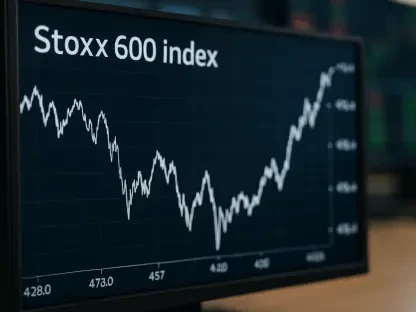The latest data for the Producer Price Index (PPI) in September reveals a subdued inflation landscape at the wholesale level, sparking widespread discourse on the future of economic policy and market dynamics in the U.S. This report delves into the recent PPI figures, juxtaposes them with Consumer Price Index (CPI) data, and interprets the potential ramifications for Federal Reserve strategies and market behavior.
September PPI Overview: Unchanged Landscape
The PPI for September remained flat compared to the previous month, defying economists’ expectations of a slight increase. Year-over-year, the PPI rose by 1.8%, down from prior months’ figures, signifying a potential easing of inflationary pressures at the producer level. This stagnation offers a glimmer of hope for broader inflation control and may contribute to a more stable economic environment.
Excluding volatile items such as food and energy, the PPI edged up by 0.2%, aligning precisely with forecasts. Its annual rise of 2.8% underscores a moderate inflationary trend. The muted change in the PPI suggests a stabilizing cost environment for producers, which could translate into fewer cost-push pressures on consumer prices. This data is crucial as it reflects the starting point for many goods in the production process, influencing overall economic stability.
The flat PPI suggests that wholesalers are not facing the same escalation in prices as seen in previous months. This easing could eventually feed into consumer prices, aligning them more closely with the Federal Reserve’s targets. However, it is important to keep in mind that this one-month snapshot might not tell the entire story, and extended trends need careful monitoring to confirm whether inflation woes are genuinely abating.
Contrasting CPI Data: Different Measures, Similar Trends
While the PPI measures the prices producers receive for their goods and services, the CPI tracks the costs consumers pay. In September, the CPI showed a 0.2% month-over-month rise and a 2.4% increase year-over-year. Comparing the PPI with CPI is pivotal for understanding the broader inflation dynamics because different movements in these indices can signal shifting economic pressures affecting both producers and consumers.
The slight uptick in CPI, alongside the flat PPI, paints a mixed picture. Consumers are experiencing gradual price increases, particularly in everyday goods and services, while producers are not necessarily facing the same pressures. This disconnect might reflect shifts in supply chain dynamics, changes in consumer purchasing patterns, or different pricing strategies employed by producers to absorb increased costs without passing them onto consumers immediately.
Despite the variances, both the PPI and CPI suggest a trend towards easing inflation. The CPI’s modest rise indicates that although consumers are not out of the woods yet, inflationary pressures are not as intense as they were during the peak periods. This gradual convergence between production and consumer prices might eventually lead to a more balanced economic situation, easing the burdens on both businesses and households.
Market Reactions: From Tepid to Turbulent
Initial market reactions to the PPI data were rather subdued, with equities remaining stable. However, this narrative shifted dramatically later in the trading session as strong earnings reports from major banks came in, propelling the Dow Jones Industrial Average up by over 300 points. This dichotomy in market behavior highlights the complex landscape of investor sentiment, where fundamental economic indicators intersect with corporate performance metrics.
The interplay between economic data releases like PPI and CPI and individual corporate earnings serves as a powerful reminder of the multifaceted nature of market expectations. While the subdued PPI initially suggested a tepid reaction, the strong bank earnings overshadowed these concerns, illustrating that markets are not driven by a single factor but by an amalgamation of influences. Investors might have viewed the positive earnings reports as an indication of healthy corporate fundamentals, temporarily alleviating broader inflation concerns.
Moreover, the surge in markets due to strong earnings further underscores how macroeconomic factors and corporate performance are deeply interconnected. Market participants often look beyond immediate economic indicators to gauge the overall health of the financial ecosystem, combining varied data sets to form a comprehensive investment strategy. This multifaceted approach is crucial for navigating the ever-evolving economic landscape, where new data points can shift expectations rapidly.
Inflation Trends: Persistent Yet Easing
Despite recent data suggesting a cooling trend in inflation, it remains above the Federal Reserve’s 2% target rate. While there has been an easing from the peak inflation rates observed over the last two years, this cooling is not uniformly distributed across all economic sectors. Persistent inflationary pressures in critical categories like shelter, food, and vehicles continue to pose substantial challenges.
The mixed signals from various economic indicators reiterate the necessity for a more granular analysis of inflation trends. While the overall headline numbers might suggest a favorable trend, sector-specific inflation can have disproportionate impacts, requiring nuanced policy responses to address the distinct challenges within each category. For instance, the persistent inflation in shelter costs affects household budgets more directly, necessitating targeted interventions.
These persistent inflationary pressures in specific sectors highlight the complexities facing policymakers. While the general trend might offer some optimism, the diverse impacts necessitate continued vigilance and adaptable strategies. Inflation routing in critical expense categories means that households still face financial strain, influencing consumption patterns that have broader economic implications. The Federal Reserve will need to consider these diverse pressures as it formulates policy to support long-term economic stability.
Federal Reserve Policy: Navigating a Divided Consensus
Federal Reserve officials have acknowledged the positive trend towards baseline inflation, expressing cautious optimism. However, minutes from the September meeting reveal a split among officials regarding interest rate decisions, with some advocating for a more aggressive approach, such as cutting the benchmark rate by half a percentage point.
Market projections suggest that rate cuts of a quarter percentage point in each of the year’s remaining meetings are expected. This divided stance within the Federal Reserve reflects the complex balancing act they must perform: fostering economic growth while keeping inflation in check. The differing opinions within the Fed underscore the lack of a one-size-fits-all solution, highlighting the intricate dynamics at play in managing the U.S. economy.
The anticipated rate cuts signal a cautious approach to monetary policy. The Federal Reserve appears to be laying the groundwork for a gradual easing of financial conditions, responding to the current economic landscape of persistent but easing inflation. This strategy aims to strike a balance between supporting economic growth and mitigating financial instability risks.
The implications of these decisions are far-reaching. Market expectations are closely tied to Federal Reserve policies, and any deviation from anticipated actions could prompt significant market reactions. As such, the Fed’s future moves will be critical in shaping economic stability and investor confidence, making it essential for policymakers to communicate their strategies clearly and effectively.
Consumer Sentiment and Inflation Expectations
The University of Michigan’s Survey of Consumers indicated a dip in sentiment for October, with one-year inflation expectations rising to 2.9%. This uptick in expected inflation underscores growing concerns about near-term price increases, which can significantly influence consumer behavior and spending patterns.
The rise in inflation expectations, despite stable PPI figures, is a critical indicator of consumer sentiment. It suggests that consumers perceive ongoing inflationary pressures in their day-to-day expenses, particularly in essential goods and services. This sentiment can lead to altered spending habits, with potential ripple effects on broader economic activity. For instance, consumers might delay discretionary spending or prioritize saving over immediate consumption, impacting retail sales and economic growth.
This rising consumer wariness about inflation, coupled with a cooling PPI, paints a nuanced picture of the current economic landscape. While producers might be experiencing some relief, consumers remain cautious, reflecting the intricate dynamics of inflation expectations. These expectations are pivotal, as they can become self-fulfilling if consumers change their spending behavior in anticipation of higher prices, thus influencing overall economic conditions.
Breakdown of PPI Components: Goods vs. Services
The latest data for the Producer Price Index (PPI) in September paints a picture of subdued inflation at the wholesale level, which has sparked widespread discourse about the future of economic policy and market dynamics in the United States. This report delves into the recent PPI figures, comparing them with the Consumer Price Index (CPI) data to offer a comprehensive view of the overall economic landscape. The implications for Federal Reserve policies are significant. The subdued PPI suggests that inflationary pressures may be easing, which would likely impact the Federal Reserve’s approach to interest rates and monetary policy. While consumer prices, as indicated by the CPI, provide insights into inflation at the consumer level, the PPI gives an early indication of upstream cost pressures, thus offering a broader perspective on inflation trends. Market behavior is also influenced by these indices, as investors and analysts use them to gauge economic conditions and make informed decisions. This nuanced understanding is critical for anyone interested in the future trajectory of the U.S. economy.









